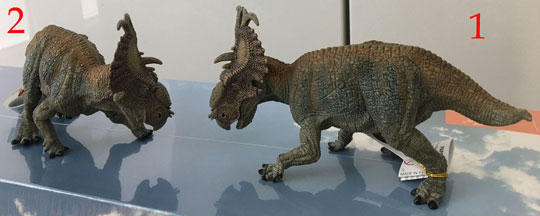Trackways Indicate Dinosaurs Roamed Alaska in the Jurassic
The discovery of dinosaur fossils in Alaska, indicating that dinosaurs lived at northern latitudes at the end of the Cretaceous was surprising, after all the debate as to whether these animals were warm-blooded or cold-blooded still rages. Over the last twenty years or so, palaeontologists have uncovered an amazing ecosystem indicating that many different types of dinosaur spent at least some of the time up north, perhaps migrating there annually to take advantage of the long summer days and abundant plant growth.
Alaskan Dinosaurs
Now a team of researchers have re-discovered a set of three-toed tracks, that suggest that some dinosaurs may have roamed southwestern Alaska in the earlier Jurassic Period.
University of Alaska Fairbanks scientists have documented the fossilised tracks of a small, theropod (meat-eating), dinosaur that appear to date from the Jurassic. If this evidence is proved to be dinosaur footprints, then it puts back the existence of dinosaurs in the U.S. state by more than seventy million years.
Although no evidence of polar ice caps in the Jurassic Period has been found, it is likely that even though Alaska was not as far north as it is today, there was almost certainly winter snow and ice. Fossil evidence (flora and fauna) found in Siberia and elsewhere in the world suggest that even lands close to the poles had relatively mild climates when compared to today. For example, plant fossils associated with areas of the world that were at high latitudes during the Jurassic; indicate average annual temperatures of no more than 8 degrees Celsius – decidedly chilly and not the sort of climate one would associate with reptiles like the dinosaurs.
Even though the world was much warmer in the Jurassic than it is in modern times, the short days of the polar winter would still have meant that plant food was scarce for a considerable part of the year, and conditions would have been tough for animals that were permanent residents.
Earth sciences curator at the University of Alaska Museum of the North, and assistant professor at the University of Alaska Fairbanks department of geology and geophysics, Patrick Druckenmiller commented:
“In one fell swoop we pushed the record of dinosaurs in Alaska back.”
In 1975, geologists mapping strata near Chignik Bay, on the south side of the Alaskan peninsula and approximately 250 miles southwest of Anchorage, discovered what appeared to be three-toed dinosaur tracks located part way up a sandstone cliff. The group photographed the site but did not collect any other data, and crucially they did not mark the exact location of their find.
Summer Excavations
Last summer, Dr Druckenmiller and a team of researchers set out to find the location in the photograph and study the trace fossils. The team included Kevin May from the museum plus University of Alaska Fairbanks geologists and an invertebrate palaeontologist, Robert Blodgett of Anchorage.
Reaching the remote site, was only part of the problem, the team hoped that the local vegetation had not changed so much that the original site would be impossible to find and there was always the threat of bear attack, plus the nuisance of biting insects to contend with. The precise location of the tracks was uncertain, so the team obtained permission to work both on Chignik Lagoon Native Corporation land and in the Alaska Peninsula National Wildlife Refuge.
Aided by the provision of a helicopter to help ferry the team to the area, the scientists established a field camp and started to prospect for fossils. After only two days of searching they discovered the footprints.
A member of the field team said:
“After staring at the 1975 photograph for so long, it was a real thrill to finally see it in real life.”
The layer of tracks was tilted nearly vertically and could only be reached with the help of climbing gear. Once they had reached the site, Dr Druckenmiller and his team made replicas of each of the prints so that they can be returned to the museum for closer analysis.
Dr. Druckenmiller commented on the amount of information the field workers were able to gather:
“Based on their size and shape, we can tell that the tracks were made by a human-sized, meat-eating (Theropod) dinosaur. We could even see impressions from tips of their claws. That makes these tracks especially rare.”
Analysis of the rock strata (sandstone) indicates that the dinosaur walked along a sandy beach, before time and geology turned the trackways into constituent parts of an Alaskan cliff face.
Pachyrhinosaurus Fossils have been Discovered in Alaska

Papo Pachyrhinosaurus dinosaur model. Fossils of a species of Pachyrhinosaurus have been found in Alaska. Picture credit: Everything Dinosaur.
Picture credit: Everything Dinosaur
The model (above), is from the Papo model range, to view Papo prehistoric animals: Papo Prehistoric Animal Models.
Dr Druckenmiller went onto add that the findings provide an entirely new chapter in the story of the life that once existed in Alaska and he added that he hoped to return to that site in the near future to continue this work.
As this part of Alaska remains relatively unexplored for Mesozoic fossils he and his team are confident that more discoveries will be made.
Dr Druckenmiller concluded:
“We are pretty sure there are other surprises waiting for us out there.”
Although it is very difficult to associate a specific genus of dinosaur to the trackways, the presence of small theropod tracks poses some interesting questions. For example, was this animal a resident of the area or a migrant, perhaps following herbivores north as they looked for plant food? Indeed, one could speculate that this is a juvenile animal, perhaps one that scavenged along the shoreline to see what animals had been stranded by the tide.
More fossils will have to be found before scientists can begin to piece together the ecosystem that once existed in ancient Alaska.






Leave A Comment